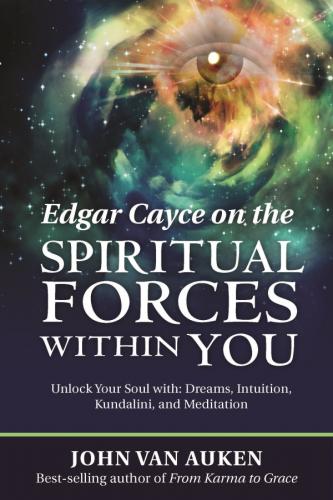Edgar Cayce on the SPIRITUAL FORCES WITHIN YOU
Edgar Cayce on the SPIRITUAL FORCES WITHIN YOU
Unlock Your Soul with Dreams, Intuition, Kundalini, and Meditation
JOHN VAN AUKEN
A.R.E. Press • Virginia Beach • Virginia
Copyright © 2014
by John Van Auken
1st Printing, June 2014
Printed in the U.S.A.
All rights reserved. No part of this book may be reproduced or transmitted in any form or by any means, electronic or mechanical, including photocopying, recording, or by any information storage and retrieval system, without permission in writing from the publisher.
A.R.E. Press
215 67th Street
Virginia Beach, VA 23451-2061
ISBN 13: 978-0-87604-733-0
Edgar Cayce Readings ©1971, 1993-2007
by the Edgar Cayce Foundation.
All Rights Reserved.
Cover design by Christine Fulcher
Contents
Chapters
3. Life Forces, the Soul, and Spirit
7. The Body-Mind-Spirit Connection
8. Your Ideal Is Your Mind’s Navigator
13. Health, Healing, and Rejuvenation
Appendix: Edgar Cayce’s Correlation of the Revelation with the Seven Spiritual Centers of Our Bodies
Introduction
I first read about Edgar Cayce when I was sixteen years old. My father, a naval officer, had been transferred to Virginia Beach, Virginia—home to the headquarters of the Edgar Cayce Foundation and the Association for Research and Enlightenment, founded by Edgar Cayce in 1931. The book was The Sleeping Prophet by Jess Stearn, a journalist and author of more than thirty books, nine of which were bestsellers. But it wasn’t until I got into college that I really began to study Cayce’s work. The professor of my writing class assigned us to write about a mystery, and since my mother had told me the mysterious story of Bridey Murphy, I thought that would be a good place to begin my research for this paper.
Bridey Murphy was the alleged name of a woman’s past life in the 1800s as an Irishwoman who died and reincarnated in the United States 59 years later. The book was The Search for Bridey Murphy by Morey Bernstein (published in 1952; it became a movie in 1956, starring Academy-Award winning actress Teresa Wright). It was the fascinating story of housewife Virginia Tighe (called Ruth Simmons in the book and movie), who, while under hypnosis, recalled (or virtually relived) her apparent past life as Bridey Murphy. Tighe’s hypnotic story (recorded on cassette tape) began in 1806, when Bridey was eight years old and living in or near Cork, Ireland. She was the daughter of Duncan Murphy, a barrister, and his wife Kathleen. At the age of 17, she married barrister Sean Brian McCarthy and moved to Belfast. Tighe told of a harsh fall season that caused Bridey’s death and of watching her own funeral. She described her tombstone and the state of being alive after her death—or more precisely, after her body’s death—in 1864. She said that she did not feel pain or sadness. Then, somehow, she was reborn in the Midwest of the U.S. in 1923. In this life, she had never been to Ireland and did not speak with even the slightest hint of an Irish accent—except when she was under hypnosis and “reliving” the Bridey incarnation! Then she spoke with an Irish brogue. In Bernstein’s book, he referred to Edgar Cayce and his remarkable abilities, explaining that he had investigated Cayce and could find no deception or trickery in his process. He thought that, as impossible as it may seem, the volumes of detail coming through Cayce on past lives couldn’t be anything but valid. Reading this, I decided to write my paper on the mystery of Edgar Cayce. Because it contained so many examples of Cayce’s readings on past lives and the karma that affected people’s present lives, I chose to use the best-selling book Many Mansions by Gina Cerminara. I got an “A” on my paper. But more than that, I developed an appetite for the Edgar Cayce information on past lives and karma.
Over the years, I read most every book about Edgar Cayce that there was. And though the initial “hook” that got me into the Cayce volumes was reincarnation and karma, it was the mystical, magical spirituality that filled his discourses that ultimately became my soul’s meat and potatoes. My soul and mind were being nourished by his spirituality. I could not get enough of his wisdom and stories, even though it was thick with King James biblical language and Christian terminology and concepts—things I had long ago deemed inadequate and often prejudiced, even racist and sexist, with a terrible history of violence. But Cayce’s perspective on Christian concepts was so open and so expansive, so beyond church dogma, doctrine, and historical acts, that I couldn’t get enough of it. His teachings included Buddhism and Hinduism. In fact, he taught that any faith that teaches the brotherhood and sisterhood of all humanity and the oneness of God was carrying the true message. In my twenties, this was exactly how I felt. His views found a receptive, responsive place within me. And the organization that built up around his work was open to all people from varying backgrounds and beliefs. They were “normal” people, not cultists, not living on the fringes of life, but quite a spread from our society.
Now, after more than forty years
